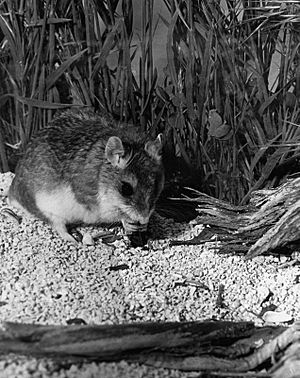Grasshopper mouse facts for kids
Quick facts for kids Grasshopper miceTemporal range: Early Pliocene – Present
|
|
|---|---|
 |
|
| A grasshopper mouse eating a beetle | |
| Scientific classification |
|
| Kingdom: | Animalia |
| Phylum: | Chordata |
| Class: | Mammalia |
| Order: | Rodentia |
| Family: | Cricetidae |
| Subfamily: | Neotominae |
| Tribe: | Reithrodontomyini |
| Genus: | Onychomys Baird, 1857 |
| Species | |
|
Onychomys arenicola |
|
Grasshopper mice are special rodents found in North America. They belong to the group called Onychomys. Unlike many other mice, they mostly eat insects and other small creatures with hard shells, known as arthropods.
Contents
Amazing Mouse Facts: What Are Grasshopper Mice?
These mice are quite unique! There are three different kinds of grasshopper mice. They are not closely related to the common house mouse you might know. You can find them living in the United States and Mexico.
The southern grasshopper mouse has a body about 9 to 13 centimeters (3.5 to 5 inches) long. Its tail is usually about 2.5 to 6.5 centimeters (1 to 2.5 inches) long. Their behavior is very different from other mice.
Hunting and Howling: A Mouse Like No Other
Grasshopper mice are carnivores, meaning they eat meat. Their diet includes insects like grasshoppers, worms, spiders, centipedes, scorpions, and even small snakes. They also hunt and eat other mice.
These mice hunt like a cat, quietly sneaking up on their prey. They are also known for defending their home by "howling" like a tiny wolf. This makes them very special among mice!
Super Powers: Immune to Venom!
One amazing fact about grasshopper mice is that they are immune to many venoms. This includes the poisons from scorpions and snakes they hunt. They are active at night and stay away from bright lights.
Where Grasshopper Mice Live: Their Environment
What Do Grasshopper Mice Eat?
Grasshopper mice are brave hunters. They often catch and eat very venomous arthropods. For example, they hunt centipedes, which can inject deadly poison.
When hunting a centipede, the mouse moves quickly. Centipedes can only inject their poison if they hold their prey with their sharp claws. The mouse stays out of reach and bites the centipede's hard outer shell. Each bite harms the centipede's nervous system. Soon, the centipede is paralyzed, and the mouse can eat it safely.
Another dangerous creature they eat is the Arizona bark scorpion. These scorpions are common in the deserts of the southwest United States. Grasshopper mice survive by eating them, especially when other food is scarce.
Hunting Habits: Fast and Smart Hunters
Grasshopper mice are very aggressive hunters. If they are kept with other mice, they might even kill and eat them.
They are not very fast in open areas because of their short legs and wide bodies. However, they are very good at moving in tight spaces. This helps them catch prey easily in narrow areas.
How Grasshopper Mice Work: Their Bodies
Pain Control: A Special Ability
Grasshopper mice and bark scorpions have changed together over a long time. This is called coevolution. Scorpions use their stinger to inject poisons that cause pain. But as scorpion venom became stronger, the mice also changed.
Grasshopper mice have special nerve cells that can block these poisons. This stops them from feeling pain signals. Scientists have found that a small change in their body helps them ignore the scorpion's sting.
Compared to a normal house mouse, the grasshopper mouse has one extra part in a protein. This change stops the mouse from feeling pain when stung by scorpion venom. By studying this, scientists hope to create new pain-relieving medicines.
Talking Like a Mouse: How They Communicate
Grasshopper mice have six different types of calls. Two are used by baby mice, and four by adult mice. They use these calls to tell each other apart, like their species, gender, or even who they are as individuals.
For example, bigger mice tend to have deeper voices. If they feel attacked, they will let out a quick screech or bark.
Types of Grasshopper Mice
There are three known species of grasshopper mice:
- Mearns's grasshopper mouse or Chihuahuan grasshopper mouse Onychomys arenicola
- Northern grasshopper mouse, Onychomys leucogaster
- Southern grasshopper mouse, Onychomys torridus
More About Grasshopper Mice
- The Mammals of Texas: Mearns' grasshopper mouse
- The Mammals of Texas: Northern grasshopper mouse
- University of Michigan Animal Diversity Web: Genus Onychomys
See also
 In Spanish: Onychomys para niños
In Spanish: Onychomys para niños

